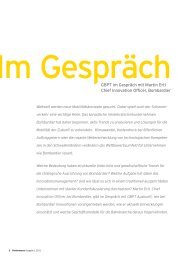PERF RMANCE 04 - The Performance Portal - Ernst & Young
PERF RMANCE 04 - The Performance Portal - Ernst & Young
PERF RMANCE 04 - The Performance Portal - Ernst & Young
Create successful ePaper yourself
Turn your PDF publications into a flip-book with our unique Google optimized e-Paper software.
Supply chain transformation<br />
• Managing the many critical linkages<br />
between the output of the different<br />
workstreams while managing the critical<br />
path for the implementation of the overall<br />
SCALE program<br />
• Managing the ongoing rollout of the<br />
program deliverables through a series of<br />
waves or pilots<br />
• Sharing lessons learned during the<br />
journey and tracking the real tangible<br />
values being realized<br />
• And building one supply chain community<br />
at the same time<br />
We followed a simple rule which was to give<br />
the overall SCALE program a series of<br />
distinct targets at a strategic level while<br />
having specific and tangible, tactical goals<br />
for the separate workstreams.<br />
Team charters were completed by all of the<br />
SCALE workstreams. As well as covering<br />
the usual issues such as scope, timeline,<br />
deliverables, roles, work-plan, linkages and<br />
dependencies, these charters also became<br />
another change instrument by addressing<br />
the potential areas for transformation and<br />
change impact (see Table 1).<br />
Table1. Potential areas for transformation impact<br />
Criteria Description Stakeholder management Critical<br />
Resulting change<br />
impacts to be<br />
managed<br />
• Local stock is legally no longer<br />
under the responsibility of the<br />
subsidiary.<br />
• Local management Low<br />
Potential<br />
resistance to<br />
these changes<br />
Recommended<br />
next steps to<br />
manage change<br />
• Local management might be<br />
afraid that they no longer control<br />
stock levels and run into stock-out<br />
situations.<br />
• In the kick-off meetings and<br />
all presentations make very<br />
transparent that the responsibilities<br />
regarding stock levels will not<br />
change because of the D-GmbH<br />
ownership.<br />
Criteria Description Stakeholder management Critical<br />
Resulting change<br />
impacts to be<br />
managed<br />
Potential<br />
resistance to<br />
these changes<br />
Recommended<br />
next steps to<br />
manage change<br />
• <strong>The</strong> handling of processes related to<br />
stock changes (e.g.,goods entry of<br />
different plants) or becomes more<br />
difficult (e.g., scrapping, customer<br />
returns) because two legal entities<br />
are involved.<br />
• Local employees might be afraid<br />
of the changes in their daily<br />
work because they do not fully<br />
understand the extent.<br />
• Explain the concrete process/<br />
handling changes in detail already<br />
in an early stage of the project and<br />
invest sufficient time for training<br />
before go live.<br />
• Employees in the<br />
warehouse (goods<br />
entry, goods issue on<br />
different plants)<br />
• Logistics clerk/<br />
manager (scrapping on<br />
D-GmbH cost center,<br />
handling of customer<br />
returns)<br />
Medium<br />
Source: Fresenius Medical Care<br />
55






